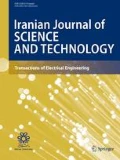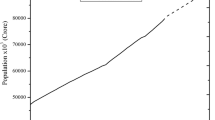Abstract
An expansion plan of a real-world power system will be more optimal when it combines the Electricity Demand Forecasting (EDF) and Generation Expansion Planning (GEP) problem. It should consider minimum error and cost; more reliability and environment concern. In this study, the EDF problem of Tamil Nadu, an Indian state, is handled by having the input data for instance Gross State Domestic Product (GSDP), Per Capita Income (PCI) and population. The electricity demand has been estimated and validated through Mean Absolute Percentage Error (MAPE) using the optimization techniques such as Artificial Immune System (AIS), Genetic Algorithm (GA) and Differential Evolution (DE). The outcomes reveal that DE outdid other algorithms. The future demands which are estimated from the EDF problem are provided as input to the GEP problem. From the results of the EDF problem, three different cases, for instance low, average and high growth rates, are framed to solve the GEP problem by minimizing the cost, environmental pollution and by enhancing the reliability. The uncertainties in demand, cost, Forced Outage Rate (FOR) and capacity credit of the power plants are considered when handling the GEP problem for short-term (6-year) and long-term (12-year) planning horizons using DE, Self-adaptive Differential Evolution (SaDE) and Opposition-based Differential Evolution (ODE). The simulation results reveal that SaDE outdid other techniques in estimating the ideal solution.









Similar content being viewed by others
References
Amosedinakaran S, Mala K, Bhuvanesh A, Marishkumar P (2020) Electricity demand forecasting using differential evolution algorithm for Tamil Nadu. In: 2020 4th International conference on trends in electronics and informatics (ICOEI)(48184), 15–17 June 2020 2020. pp 143–146. doi:https://doi.org/10.1109/icoei48184.2020.9142872
Azadeh A, Taghipour M, Asadzadeh SM, Abdollahi M (2014) Artificial immune simulation for improved forecasting of electricity consumption with random variations. Int J Electr Power Energy Syst 55:205–224. https://doi.org/10.1016/j.ijepes.2013.08.017
Behrang MA, Assareh E, Assari MR, Ghanbarzadeh A (2011) Total energy demand estimation in iran using bees algorithm energy sources. Part b: Econo, Plann, Policy 6:294–303. https://doi.org/10.1080/15567240903502594
Bhuvanesh A, Karunanithi K, Kannan S 2014 Least cost generation expansion planning with wind plant using differential evolution algorithm. In: 2014 International conference on circuits, power and computing technologies [ICCPCT-2014], 20–21 March 2014 2014. pp 540–547. doi:https://doi.org/10.1109/iccpct.2014.7055025
Bhuvanesh A, Christa STJ, Kannan S 2017 Least Cost Electricity Generation Planning for China with Low GHG Emission Using LEAP and EnergyPLAN. In: 2017 IEEE International conference on computational intelligence and computing research (ICCIC), 14–16 Dec. 2017 2017. pp 1–5. doi:https://doi.org/10.1109/iccic.2017.8524458
Bhuvanesh A, Jaya Christa ST, Kannan S, Karuppasamy Pandiyan M (2018a) Aiming towards pollution free future by high penetration of renewable energy sources in electricity generation expansion planning. Futures 104:25–36. https://doi.org/10.1016/j.futures.2018.07.002
Bhuvanesh A, Christa STJ, Kannan S, Pandiyan MK, Gangatharan K (2018b) Application of optimization algorithms to generation expansion planning problem. J Intell Fuzzy Sys. https://doi.org/10.3233/JIFS-169681
Bhuvanesh A, Jaya Christa ST, Kannan S, Karuppasamy Pandiyan M (2019a) Multistage multiobjective electricity generation expansion planning for Tamil Nadu considering least cost and minimal GHG emission. Int Transact Elect Energy Sys 29:e2708. https://doi.org/10.1002/etep.2708
Bhuvanesh A, Jaya Christa ST, Kannan S, Karuppasamy Pandiyan M, Gangatharan K (2019b) Application of differential evolution algorithm and its variants for solving energy storage technologies integrated generation expansion planning. Iran J Sci Technol Transact Elect Eng. https://doi.org/10.1007/s40998-019-00190-x
Bhuvanesh A, Karthikeyan K, Amosedinakaran S, Kannan S (2020) Generation expansion planning for india by enhancing renewable integration. J Green Eng 10:4257–4267
Central Electricity Authority, All India Installed Capacity (in MW) of Power Stations (2018) New Delhi, India
Government of India, Draft national electricity plan (2016). Ministry of power, Central electricity authority
Ceylan H, Ozturk HK (2004) Estimating energy demand of Turkey based on economic indicators using genetic algorithm approach. Energy Convers Manage 45:2525–2537. https://doi.org/10.1016/j.enconman.2003.11.010
Chen Q, Kang C, Xia Q, Zhong J (2010) Power generation expansion planning model towards low-carbon economy and its application in china. IEEE Trans Power Syst 25:1117–1125. https://doi.org/10.1109/tpwrs.2009.2036925
Dasgupta D, Yu S, Nino F (2011) Recent advances in artificial immune systems: models and applications. Appl Soft Comput 11:1574–1587. https://doi.org/10.1016/j.asoc.2010.08.024
Deb K, Mohan M, Mishra S (2003) A Fast Multi-objective Evolutionary Algorithm for Finding Well-Spread Pareto-Optimal Solutions KanGAL report 2003002
Dmund W, Sinnott LCD, Dobzhansky T (1958) Principles of genetics, 5th edn. McGraw-Hill, New York
EIA, Electric generator capacity factors vary widely across the world (2018). Energy Information Administration, US
EIA, Capital Cost Estimates for Utility Scale Electricity Generating Plants (2018) Independent Statistics & Analysis, U.S Energy information Administration, Washington
Ekonomou L (2010) Greek long-term energy consumption prediction using artificial neural networks. Energy 35:512–517. https://doi.org/10.1016/j.energy.2009.10.018
Geem ZW, Roper WE (2009) Energy demand estimation of South Korea using artificial neural network. Energy Policy 37:4049–4054. https://doi.org/10.1016/j.enpol.2009.04.049
Government of India, Power for All (2017). Ministry of Power, Energy department
Government of India, State-wise : population, GSDP, Per capita income and growth rate (2010). New Delhi
Government of tamil nadu, state income - Tamil nadu government portal (2017). Chennai
International atomic energy agency, Wien Automatic system planning (WASP) package (2001). Computer manual series no. 16, Austria.,
International renewable energy agency (IRENA), The power to change: Solar and wind cost reduction potential to 2025 (2016). Government of Germany
Guo H, Chen Q, Xia Q, Kang C, Zhang X (2018) A monthly electricity consumption forecasting method based on vector error correction model and self-adaptive screening method. Int J Electr Power Energy Syst 95:427–439. https://doi.org/10.1016/j.ijepes.2017.09.011
Kannan S, Slochanal SMR, Padhy NP (2005) Application and comparison of metaheuristic techniques to generation expansion planning problem. IEEE Trans Power Syst 20:466–475. https://doi.org/10.1109/tpwrs.2004.840451
Kato M, Zhou Y, Kang C, Yokoyama R (2011) Novel approach of modeling load duration curve for generation expansion planning based on Hill’s function. IEEJ Trans Electr Electron Eng 6:304–310. https://doi.org/10.1002/tee.20661
Kong Z, Xia Z, Cui Y, Lv H (2019) Probabilistic forecasting of short-term electric load demand: an integration scheme based on correlation analysis and improved weighted extreme learning machine. Appl Sci 9:4215
Krishnamoorthy K, Subramanian K, Subramanian B, Thangaraj C (2013) Application of self-adaptive differential evolution algorithm to generation expansion planning problem. J Electr Sys 9:203–211
National Renewable Energy Laboratory, Cost Report. Cost and Performance data for power generation technologies (2018). Washington, US
Luh G-C, Chueh C-H (2009) A multi-modal immune algorithm for the job-shop scheduling problem. Inf Sci 179:1516–1532. https://doi.org/10.1016/j.ins.2008.11.029
Ma Z, Zhong H, Xie L, Xia Q, Kang C (2018) Month ahead average daily electricity price profile forecasting based on a hybrid nonlinear regression and SVM model: an ERCOT case study. J Modern Power Sys Clean Energy 6:281–291. https://doi.org/10.1007/s40565-018-0395-3
Mir AA, Alghassab M, Ullah K, Khan ZA, Lu Y, Imran M (2020) A review of electricity demand forecasting in low and middle income countries: the demand determinants and horizons. Sustainability. https://doi.org/10.3390/su12155931
Government of Tamil Nadu, The Vision Tamil Nadu 2023. Strategic Plan for Infrastructure Development in Tamil Nadu (2014)
Office of the Registrar General & Census Commissioner, Population Projections for India and States (2001–2026) (2001). New Delhi
Central Electricity Authority, National Electricity Plan (NEP) (2018). New Delhi, India,
Institute for management research, Sub-national HDI – Area Database- Global Data Lab (2018). Radboud University
Rahnamayan S, Tizhoosh HR, Salama MMA (2008) Opposition-based differential evolution. IEEE Trans Evol Comput 12:64–79. https://doi.org/10.1109/tevc.2007.894200
Rajesh K, Bhuvanesh A, Kannan S, Thangaraj C (2016a) Least cost generation expansion planning with solar power plant using differential evolution algorithm. Renewable Energy 85:677–686. https://doi.org/10.1016/j.renene.2015.07.026
Rajesh K, Karthikeyan K, Kannan S, Thangaraj C (2016b) Generation expansion planning based on solar plants with storage. Renew Sustain Energy Rev 57:953–964. https://doi.org/10.1016/j.rser.2015.12.126
Samuel A, Krishnamoorthy M, Ananthan B, Pitchai M (2021) Application of Optimization Techniques for Estimating Electricity Demand of Tamil Nadu. In: Reddy VS, Prasad VK, Wang J, Reddy KTV (eds) Soft Computing and Signal Processing, Singapore 2021// 2021. Springer, Singapore
Saravanan S, Kannan S, Amosedinakaran S, Thangaraj C (2014) India's electricity demand estimation using Genetic Algorithm. In: 2014 International Conference on Circuits, Power and Computing Technologies [ICCPCT-2014], 20–21 March 2014 2014. pp 97–101. doi:https://doi.org/10.1109/iccpct.2014.7054814
Sözen A, Arcaklioglu E (2007) Prediction of net energy consumption based on economic indicators (GNP and GDP) in Turkey. Energy Policy. https://doi.org/10.1016/j.enpol.2007.04.029
Storn R, Price K (1997) Differential evolution – a simple and efficient heuristic for global optimization over continuous spaces. J Global Optimizat. https://doi.org/10.1023/a:1008202821328
Tamil Nadu Generation and Distribution Corporation Ltd, Electricity (2016). The Chief Engineer (Planning), Chennai,
TANTRANSCO, Tamil Nadu’s Power Scenario and Issues in RE (2017). SLDC, Chennai, Tamil Nadu
Tekiner H, Coit DW, Felder FA (2010) Multi-period multi-objective electricity generation expansion planning problem with Monte-Carlo simulation. Electric Power Sys Res 80:1394–1405. https://doi.org/10.1016/j.epsr.2010.05.007
Thangavelu SR, Khambadkone AM, Karimi IA (2015) Long-term optimal energy mix planning towards high energy security and low GHG emission. Appl Energy 154:959–969. https://doi.org/10.1016/j.apenergy.2015.05.087
Department of Energy, Lazard’s Levelized Cost of Energy Analysis (2016). United States of America,
X Wang, McDonald JR (1994) Modern power system planning McGraw-Hill, Singapore
Windarta J, Purwanggono B, Hidayanto F (2018) Application of LEAP model on long-term electricity demand forecasting in Indonesia, period 2010–2025. SHS Web of Conferences. https://doi.org/10.1051/shsconf/20184902007
Yetis Y, Jamshidi MM (2014) Forecasting of Turkey's electricity consumption using Artificial Neural Network 2014 World Automation Congress (WAC):723–728
Yu S-w, Zhu K-j (2012) A hybrid procedure for energy demand forecasting in China. Energy 37:396–404. https://doi.org/10.1016/j.energy.2011.11.015
Zhang C, Ding Y, Kang C (2013) Multi-objective generation expansion planning for integrating large- scale wind generation. In Proceedings of AORC-CIGRE Technical Meeting 2013: Smart transmission and distribution, PP. 336–344
Author information
Authors and Affiliations
Corresponding author
Appendix
Appendix
See Tables
19,
20,
21,
22,
Rights and permissions
About this article
Cite this article
Samuel, A., Krishnamoorthy, M., Ananthan, B. et al. Application of Metaheuristic Algorithms for Solving Real-World Electricity Demand Forecasting and Generation Expansion Planning Problems. Iran J Sci Technol Trans Electr Eng 46, 413–439 (2022). https://doi.org/10.1007/s40998-022-00480-x
Received:
Accepted:
Published:
Issue Date:
DOI: https://doi.org/10.1007/s40998-022-00480-x




